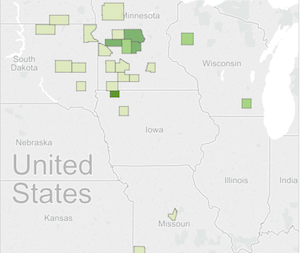Flax meal is America's newest health food fad
Thursday, June 23, 2011
What wheat germ was to the 1980s, flax meal is becoming to the 2010s.
Sprinkled over yogurt, mixed in with meatloaf or baked into bread and muffins, flaxseed is being added to foods in an effort to increase nutritional value.
Flaxseed has three primary benefits: fiber, omega-3 fatty acids and lignans, plant chemicals that are being investigated for their cancer-fighting potential.
"They contain plant estrogens that act the same way as a breast cancer drug called tamoxifen, which works against the real estrogen that can prompt certain cancers to grow," said Lea Reagan, a registered dietitian at Memorial Hospital.
Reagan said some studies showed that lignans reduced the onset of mammary tumors in lab animals. "It's still under investigation," she emphasized.
A 2011 Swedish study based on research at the Division of Oncology at Linkoping University in Linkoping, notes: "A diet with high amounts of phytoestrogens, such as flaxseed ... may affect breast cancer progression in a similar fashion as the anti-estrogen tamoxifen."
According to the Linus Pauling Institute at Oregon State University, flaxseed contains the highest number of lignans of any plant-based food product.
In order for a person to absorb all the nutrients of flax seed, the seeds must be ground into a meal. Otherwise, Reagan said, "you just get rid of it the way it goes in." Flaxseed oil is also available, but is not quite as beneficial as ground flax meal.
Flaxseed oil, she said, offers the omega-3 benefits but not fiber, and the caloric value of a tablespoon of flaxseed oil is much higher than the caloric value of a tablespoon of ground flax meal. Flaxseed oil also does not typically contain lignans, according to the Oregon State website.
Omega-3 fatty acids, which have been touted by the American Heart Association and have been pointed to as playing a role in brain function, are most commonly found in fatty fish, such as salmon and halibut. They can also be found in flaxseeds, though in a slightly different form.
According to the website for the Harvard University School of Public Health, there are several types of omega-3 fatty acids: alpha-linolenic acid (ALA), which is found in soybean oil, walnut and flaxseed; eicosapentaenoic acid (EPA), and docosahexaenoic acid (DHA), which is found in fatty fish.
"The big issue with that versus doing fish oils, which are a different kind of omega-3, is that your body has to convert the ALA in flax seed to the kind of omega-3's that are in fish," Reagan said. She added that the conversion is only about 15 percent converting it to EPA and about five percent of DHA. ALA, while beneficial, may not carry quite the same benefit as EPA and DHA, according to the University of Maryland Medical Center.
Reagan also said that a diet high in saturated fats or linolaic acids can also decrease the conversion levels.
"If you're eating a better diet, you get more out of the flax seed."
In other words, don't live on candy bars and expect to get sufficient nutrition from a handful of flax. Still, Reagan said, flax seed can be a positive addition to a healthy diet.
Contact Holly Leber at hleber@timesfreepress.com or (423) 757-6391. Follow her on Twitter at twitter.com/hollyleber.


